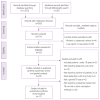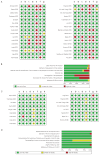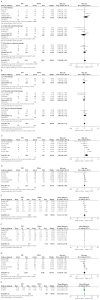Pregnancy outcomes after all modes of conception in patients with genital tuberculosis: a systematic review and meta-analysis
- PMID: 39748636
- PMCID: PMC11976926
- DOI: 10.5468/ogs.24045
Pregnancy outcomes after all modes of conception in patients with genital tuberculosis: a systematic review and meta-analysis
Abstract
This systematic review and meta-analysis aimed to summarize the pregnancy outcomes of women diagnosed with genital tuberculosis (GTB) who spontaneously conceived or underwent intrauterine insemination (IUI) or in vitro fertilization (IVF) after being treated with antitubercular therapy (ATT). Publications from the PubMed, Medline, Embase, Ovid, Scopus, Web of Science, and Google Scholar databases were searched from December 20, 2021 to March 5, 2022. The outcomes are presented as pooled averages with 95% confidence intervals. The inconsistency index (I2) test was used to measure the heterogeneity between studies. The certainty of the evidence was assessed using GRADEPro (https://www.gradepro.org/). Of the numerous articles identified, 33 met the inclusion criteria and were included in this systematic review. Generally, there was a significant increase in pregnancy rates among patients who underwent IVF compared with those who underwent ATT (37.9% vs. 23.8%; p=0.02). Conversely, there was no significant difference in pregnancy rates between patients who underwent IUI and those who conceived spontaneously (18.1% vs. 23.8%; p=0.65). In cases in which no abnormalities were found on hysterosalpingography or hysterolaparoscopy, pregnancy rates were comparable between spontaneous and IVF conceptions (48.4% vs. 49.2%). There were no significant differences in pregnancy or live birth rates between patients with GTB and those with other infertility factors undergoing IVF treatment (p>0.05). ATT, which is administered during the early stages of GTB is effective in achieving pregnancy outcomes comparable to IVF. However, in patients with advanced-stage disease, IVF is a superior treatment modality, resulting in increased pregnancy rates.
Keywords: Female genital tuberculosis; Imaging findings; In vitro fertilization; Pregnancy outcome; Spontaneous conception.
Conflict of interest statement
The authors have no conflict of interest.
Figures






Similar articles
-
In vitro fertilization and multiple pregnancies: an evidence-based analysis.Ont Health Technol Assess Ser. 2006;6(18):1-63. Epub 2006 Oct 1. Ont Health Technol Assess Ser. 2006. PMID: 23074488 Free PMC article.
-
Ovarian stimulation strategies for intrauterine insemination in couples with unexplained infertility: a systematic review and individual participant data meta-analysis.Hum Reprod Update. 2022 Aug 25;28(5):733-746. doi: 10.1093/humupd/dmac021. Hum Reprod Update. 2022. PMID: 35587030 Free PMC article.
-
Using serum anti-Müllerian hormone levels to predict the chance of live birth after spontaneous or assisted conception: a systematic review and meta-analysis.Hum Reprod. 2023 Sep 5;38(9):1789-1806. doi: 10.1093/humrep/dead147. Hum Reprod. 2023. PMID: 37475164
-
Risk of spontaneous preterm birth in singleton pregnancies conceived after IVF/ICSI treatment: meta-analysis of cohort studies.Ultrasound Obstet Gynecol. 2018 Jan;51(1):43-53. doi: 10.1002/uog.18930. Ultrasound Obstet Gynecol. 2018. PMID: 29114987 Review.
-
Screening hysteroscopy in subfertile women and women undergoing assisted reproduction.Cochrane Database Syst Rev. 2019 Apr 16;4(4):CD012856. doi: 10.1002/14651858.CD012856.pub2. Cochrane Database Syst Rev. 2019. PMID: 30991443 Free PMC article.
References
-
- World Health Organization . Global tuberculosis report 2020 [Internet] Geneva: World Health Organization; c2020. [cited 2022 Feb 21]. Available from: https://www.who.int/publications/i/item/9789240013131.
-
- Ghosh K, Ghosh K, Chowdhury JR. Tuberculosis and female reproductive health. J Postgrad Med. 2011;57:307–13. - PubMed
LinkOut - more resources
Full Text Sources
Miscellaneous

